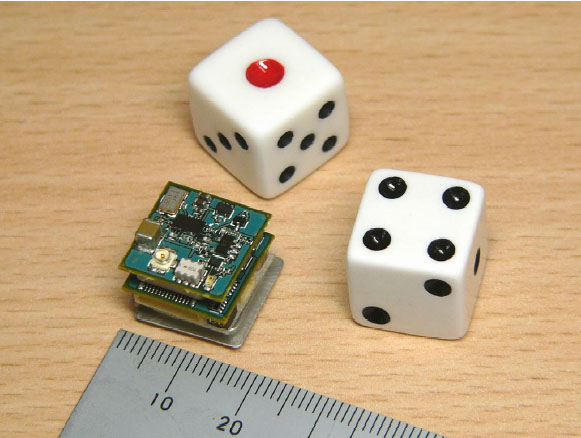


The YRP Ubiquitous Networking Laboratory held a press conference on April 27 in Gotanda, Tokyo, to report the successful development of the world's smallest active electronic tag. Named "Dice" because it is the size of a die in a set of gaming dice, the new active radio frequency identification (RFID) tag is a mere 15 millimeters square, and it is expected to cost only several hundred yen in mass production. The range of the new electronic tag is approximately 10 meters, which was demonstrated using plastic boxes simulating frozen fish and chilled vegetable delivery boxes. As the boxes were carried in from another room, a reader system automatically registered their presence within a few seconds, recorded the time, and listed their contents and temperature, which is taken using a built-in temperature sensor. A second demonstration using the new RFID involved a suitcase with a pressure sensor. After the lid was opened, a voice system in English described the contents (teacups) and told the listener to confirm them as the case had been opened. This could be used as an anti-terror system, Prof. Ken Sakamura said.
The reader system for the new active RFID has an anti-collision function that allows 1,000 Dice to be used simultaneously. This function is scheduled to be tested in verification trials at the Odaiba market and at warehouses and other facilities owned by NYK Line and Fuji Xerox Co. Under normal conditions, Dice tags will be attached to large reusable boxes, and the items inside those boxes will have passive RFIDs attached to them. Since the Dice active chip has very low power consumption, frequent battery changes will not be required during testing. The specification for the Dice active electronic tag is as follows:
|
|
|
| CPU |
|
|
|
|
|
|
|
|
19.2 Kbps |
| Security |
|
| Sensors |
|
Before closing the press conference, Prof. Sakamura also announced that the YRP Ubiquitous Networking Laboratory and the National Internet Development Agency of Korea (KRNIC) had concluded a memorandum of understanding to cooperate in the standardization of ucode search systems and Ubiquitous ID-related technologies. KRNIC was established on June 29, 1999, in Seoul, Korea, with the approval of Korean government's Ministry of Information and Communication to introduce a stable Internet address management system inside the country. It's main goal is to promote the problem-free spread of the Internet inside the Republic of Korea.
Personal Media Corporation announced on April 21 that it had begun marketing a new µT-Engine development board kit that comes standard equipped with a LAN /USB expansion board, an item that has normally been marketed as an option on the majority of the T-Engine development kits marketed to date. The new development kit, "µT-Engine/V850E-MA3 Development Kit," is based on an NEC Electronics Corporation 32-bit V850E/MA3 microprocessor that has 512 kilobytes of flash memory (read only memory, or ROM) and 32 kilobytes of random access memory (RAM) built into it. Personal Media said the peak processing speed of the new development is 106 MIPS at 80 MHz, which makes it ideal for applications where high-speed, real-time performance is required. Such applications include various types of network devices, printers, consumer appliances, and motor controllers. The hardware and software specifications for µT-Engine/V850E-MA3 Development Kit, which is being marketed at a standard price of 157,500 yen (consumption tax included) are as follows:
|
|
|
|
|
|
| CPU |
|
| Flash memory | 512 kilobytes (built into CPU) |
| RAM | 32 kilobytes (built into CPU) |
| SDRAM | 8 megabytes |
| Input/output interfaces | Compact Flash (CF) card, serial, eTRON chip interface, MMC card, expansion bus interface, JTAG-ICE interface |
| Other functions | Real-time clock (RTC) |
| Power supply | AC adapter |
| External dimensions | 60 mm x 85 mm (without protuberances) |
|
|
|
| Flash memory | 1 megabyte (on the expansion board) |
| LAN |
|
| USB (Function) |
|
| Other functions | Sound input, sound output |
| Connectors |
|
| External dimensions | 60 mm x 85 mm (without protuberances) |
|
|
|
|
The YRP Ubiquitous Networking Laboratory announced on April 8 that it would be carrying out ubiquitous computing network verification trials in the famous Asakusa entertainment district in the east end of Tokyo between April 12 and the end of May. The goal of the trials, which were launched in a ceremony that took place inside the famous Asakusa Buddhist temple, is to provide multilingual (Chinese, English, Japanese, and Korean) tourist information to tourists using uID tags and markers and Ubiquitous Communicators, with the latter to be loaned out to tourists staying in hotels located in the Asakusa district. Several hundred uID tags and markers, which can be read by the UC to obtain information from an on-line database, will be will be attached both to points of historical interest and various shops. The organizations cooperating in the trials are the Ministry of Land, Infrastructure and Transport, the Asakusa District Tourist Guide System Promotion Committee, and the YRP Ubiquitous Networking Laboratory. Up to this point, most of the verification trials aimed at tourists and shoppers have taken place outside of Tokyo.